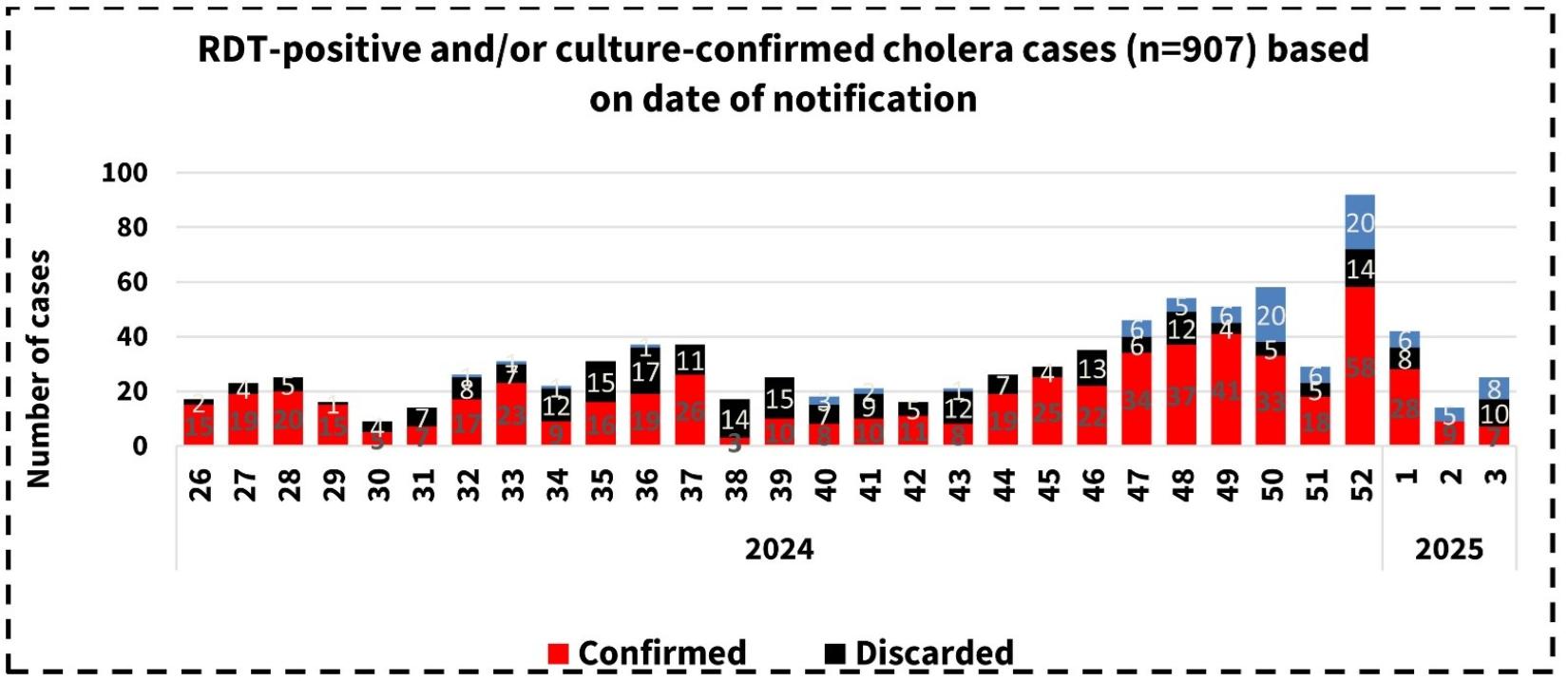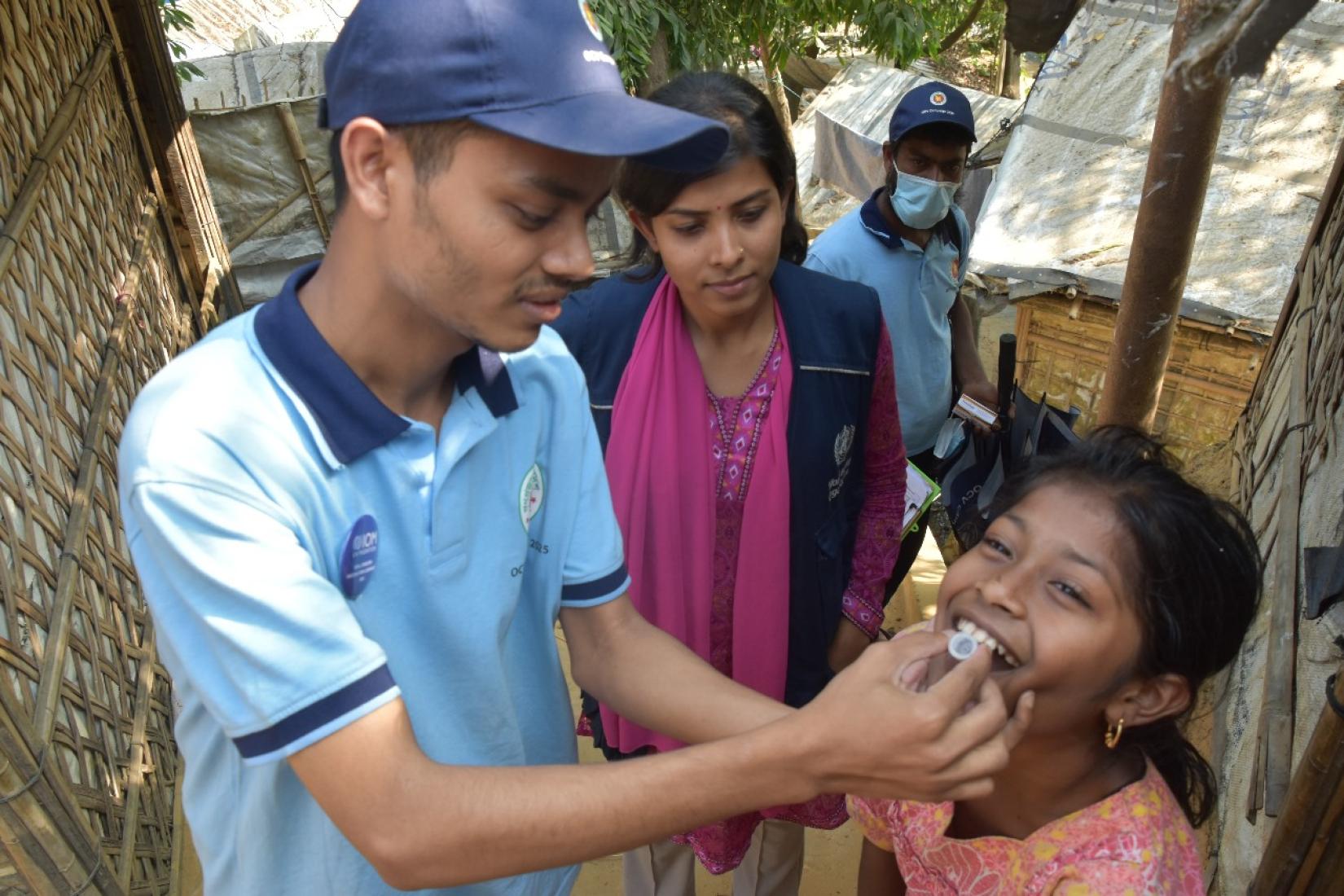Landmark Cholera Vaccination Campaign Offers Hope to Rohingya Refugee Camps!

29 January 2025
Cholera has been endemic in Bangladesh for decades, with seasonal peaks. It has remained a major health concern in the Rohingya refugee camps since 2017. While acute watery diarrhea trends in 2024 align with previous years, culture-confirmed cases have declined since the large outbreaks in 2019 (283 cases) and 2021 (136 cases). Annual cases dropped further in 2022 (70 cases) and 2023 (81 cases), following a successful Oral Cholera Vaccine campaign in 2021 that achieved 86% population coverage.
In a major collaborative effort, the Government of Bangladesh, with support from WHO, UNHCR, and Health Sector partners, launched a landmark cholera vaccination campaign in the Rohingya refugee camps on January 12, 2025. This initiative targeted individuals aged one year and older, following a rise in cholera cases detected through WHO’s sentinel surveillance system in both the camps and surrounding host communities.
Between January 12 and 18, 2025 (Epidemiological Week 3), the WHO surveillance system recorded 572 culture-confirmed cholera cases in Ukhiya and Teknaf Upazilas, marking the highest surge since the large-scale refugee influx in 2017 (As shown in the graph). Alarmingly, 94% of the cases (536) were reported within the refugee camps, while the remaining 6% (36 cases) were identified in host communities across Ukhiya, Teknaf, Ramu, and Naikhonchhori in Cox’s Bazar and Bandarban Districts.

Epi curve of Cholera cases from 23 Jun 2024 to 18 Jan 2025 (Early Warning 26, 2024- 3, 2025).
Source: Early Warning, Alert and Response System (EWARS).
“At a time when we are making strides toward controlling cholera and diarrheal diseases, this campaign stands as a testament to the power of collaborative action. We are deeply grateful for the collaborative efforts that made it possible,” said A. T. M. Saiful Islam, Additional Secretary (Public Health Wing), Ministry of Health and Family Welfare.
Cholera, an acute diarrheal infection caused by ingesting contaminated food or water, continues to pose a significant global health challenge, with 1.3 to 4 million cases and up to 143,000 deaths annually.
The five-day vaccination campaign (January 12–16, 2025) aimed to reach 943,174 individuals across 33 camps and Bhasan Char Island. Over 1,700 community health workers, supervisors, and Health Sector partners visited 194,907 households to administer the single-dose Euvichol Plus vaccine.
WHO, in partnership with PATH (formerly the Program for Appropriate Technology in Health) and the International Centre for Diarrhoeal Disease Research, Bangladesh (icddr, b), conducted Training of Trainers (ToT) sessions for community health workers and WASH sector supervisors. These sessions covered key topics such as vaccination techniques, cold chain management, documentation, and reporting, ensuring a smooth and effective rollout of the campaign.
Dr Orwa Al Abdulla, Health Sector Coordinator and Acting OIC at the WHO Sub-office in Cox’s Bazar, emphasized the importance of partnership: “We are immensely grateful to the Refugee Relief and Repatriation Commissioner, the Civil Surgeon’s Office, and all partners for their vital contributions. Continued collaboration will be crucial in addressing future public health challenges.”
The WHO-led Health Sector adopted a scenario-based approach to prepare for the campaign, coordinating with partners and implementing a multi-sectoral cholera action plan. Cholera culture detection was carried out at the WHO-supported IEDCR Field Laboratory at Cox’s Bazar Medical College, with additional surveillance and culture detection managed by icddr,b in Dhaka, in collaboration with WHO and MoH.
To bolster case management, WHO provided partners with central cholera kits capable of treating 100 severe dehydration cases of Acute Watery Diarrhoea (AWD). Additional kits were also prepared to address potential surges in cases.
To bolster case management, WHO provided partners with central cholera kits capable of treating 100 severe dehydration cases of Acute Watery Diarrhoea (AWD). Additional kits were also prepared to address potential surges in cases.
UNHCR’s Community Health Working Group (CHWG) reached over 572,000 Rohingya refugees and host community members with essential AWD prevention messages, while the WASH sector conducted water quality assessments in coordination with the Department of Public Health Engineering.
By the end of the campaign, 976,751 individuals had been vaccinated, surpassing the planned estimate for target population. Coverage rates reached 102.5% in Ukhiya and 108.9% in Teknaf, which can be attributed to recent influx of refugees and potential inaccuracies in the denominator. “I feel safe and protected now,” said 14-year-old Konisha Bibi, a vaccine recipient.
This historic campaign underscores the critical role of collaboration in addressing public health challenges. As Bangladesh continues its efforts to control cholera outbreaks, sustained investments in water, sanitation, and hygiene infrastructure will be crucial to preventing future cases and safeguarding the health of vulnerable communities.


